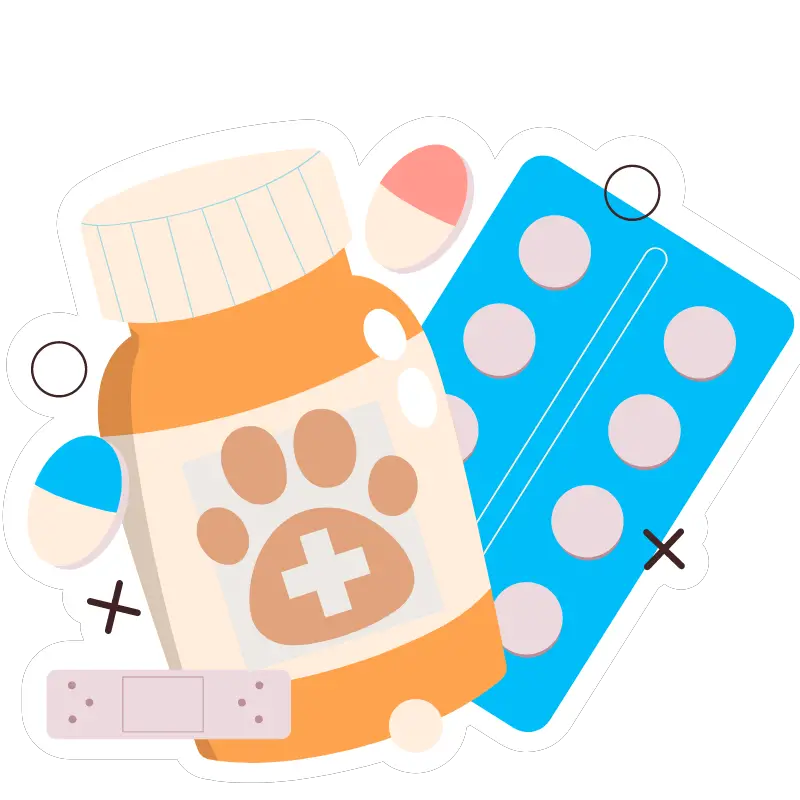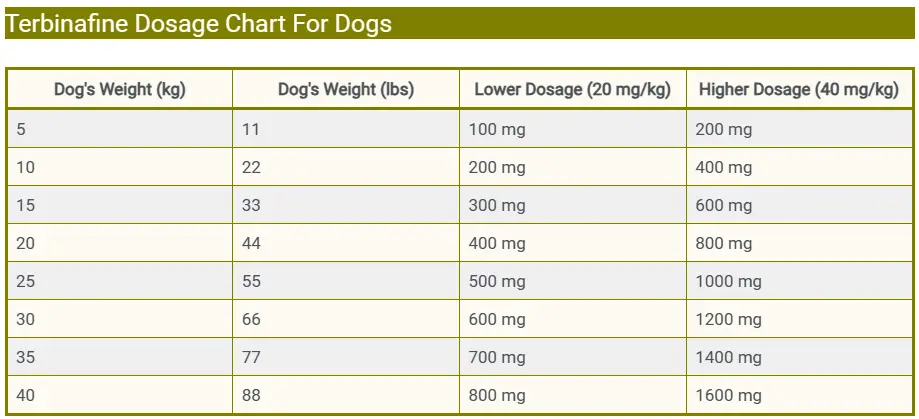A standard dosage of terbinafine for dogs to treat skin or ringworm infections ranges from approximately 20 to 40 milligrams per kilogram (mg/kg) of body weight, administered orally once daily. However, the dosage can be adjusted based on the severity of the infection.
Terbinafine Dosage For Dogs

-
Ideal Dose: 20-40 mg/kg
-
Uses: Skin or ringworm infections
-
FDA Approved: No
-
Variants: Tablets
-
Storage & Handling: Room Temperature
-
Administration: Once Daily
Disclaimer: Self-medication can be hazardous. Please consult your veterinarian for personalized guidance on the appropriate dosage for your furry friend’s specific condition.
Finding the proper treatment becomes a priority when our furry companions suffer from fungal infections like ringworm or dermatophytosis.
Terbinafine, a medication commonly used to combat fungal infections in humans, has found its way into veterinary medicine for treating similar dog conditions.
However, determining the correct dosage for our canine friends is crucial to ensure their safety and effective recovery.
In this blog post, we delve into the nuances of terbinafine dosage for dogs, shedding light on the considerations and guidelines pet owners should be aware of when administering this medication to their beloved pets.
Terbinafine Dosage For Dogs
The terbinafine dosage for dogs can vary depending on the dog’s weight, the condition being treated, and the veterinarian’s recommendation. Terbinafine is commonly used in veterinary medicine to treat fungal infections, particularly dermatophytosis (ringworm).
A typical dosage range for terbinafine in dogs is approximately 5 to 15 milligrams per kilogram (mg/kg) of body weight, administered orally once daily. However, it’s essential to follow the vet’s instructions. They will determine the appropriate dosage based on the dog’s needs and health status.
It’s crucial to complete the entire course of treatment as the veterinarian prescribes, even if the dog’s symptoms improve before the treatment is finished. Abruptly stopping terbinafine could lead to a recurrence of the fungal infection.
As with any medication, monitoring your puppy for any potential side effects and promptly reporting any concerns to the veterinarian is essential. Common side effects of terbinafine in dogs may include gastrointestinal upset, such as vomiting or diarrhea, and, in rare cases, liver toxicity.
Terbinafine Dosage Chart For Dogs
| Dog’s Weight (kg) | Dog’s Weight (lbs) | Lower Dosage (20 mg/kg) | Higher Dosage (40 mg/kg) |
|---|---|---|---|
| 5 | 11 | 100 mg | 200 mg |
| 10 | 22 | 200 mg | 400 mg |
| 15 | 33 | 300 mg | 600 mg |
| 20 | 44 | 400 mg | 800 mg |
| 25 | 55 | 500 mg | 1000 mg |
| 30 | 66 | 600 mg | 1200 mg |
| 35 | 77 | 700 mg | 1400 mg |
| 40 | 88 | 800 mg | 1600 mg |
Related Post: Thyro Tabs Dosage For Dogs
Uses
-
Treating dermatophytosis (ringworm), a contagious fungal infection affecting the skin, hair, and nails.
-
Addressing various fungal skin infections in dogs, including yeast infections and those caused by Microsporum and Trichophyton species.
-
Alleviating paw pad infections caused by fungi, relieving discomfort and promoting healing.
-
Managing fungal infections in the nail beds (onychomycosis), facilitating the growth of healthy nails.
-
Occasionally used as part of treatment for systemic fungal infections in dogs, under veterinary supervision.
Related Post: Benadryl Dosage For Dogs
Potential Side Effects
-
Gastrointestinal upset: vomiting, diarrhea, loss of appetite
-
Liver toxicity: jaundice, lethargy, changes in appetite and behavior
-
Allergic reactions: itching, swelling, difficulty breathing, hives
-
Neurological symptoms: tremors, seizures, confusion
-
Changes in blood cell counts: anemia, thrombocytopenia
Which Dogs Should Not Take Terbinafine
Canines with the following health issues should not take terbinafine without veterinary recommendations.
-
Dogs with liver disease
-
Dogs with known allergic reactions to terbinafine or similar medications
-
Pregnant or lactating dogs
-
Dogs with severe kidney disease
-
Dogs taking medications that may interact with terbinafine










![Can Dogs Eat Blood? 7 Side Effects [Expert Opinion]](https://petskor.com/wp-content/uploads/2022/04/Webp.net-resizeimage-12.jpg)
